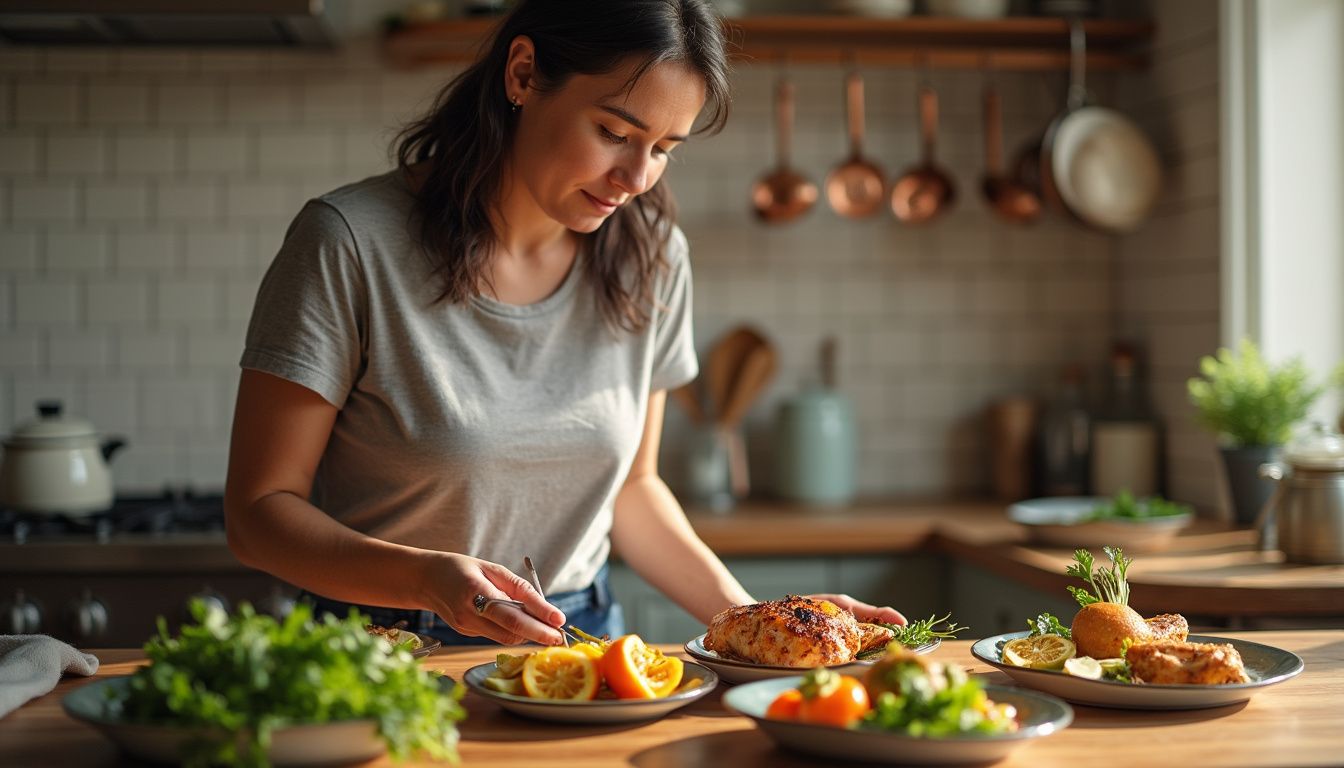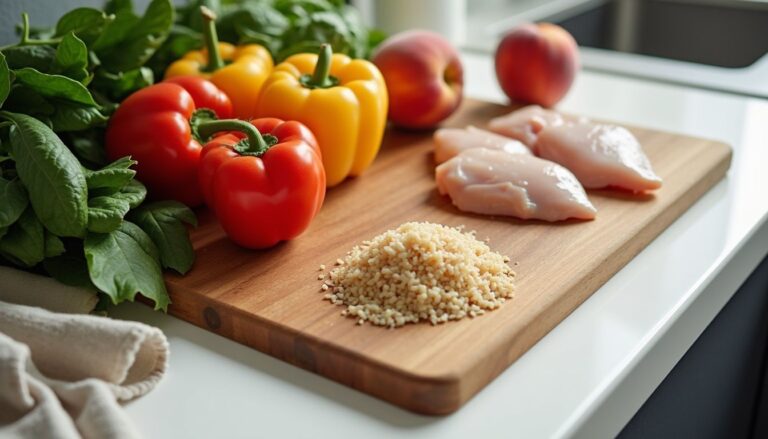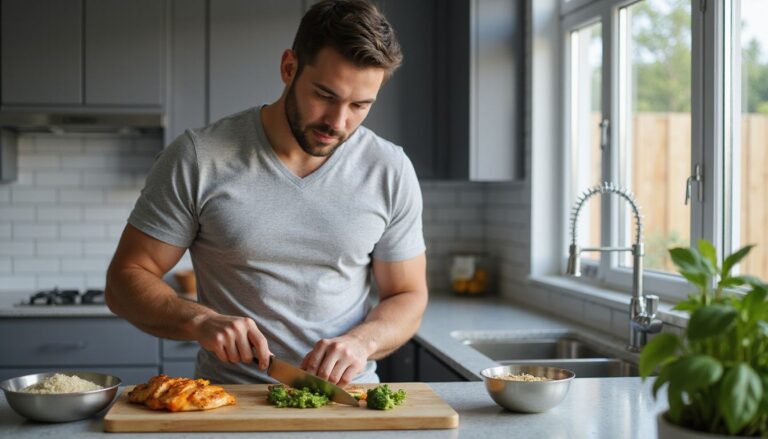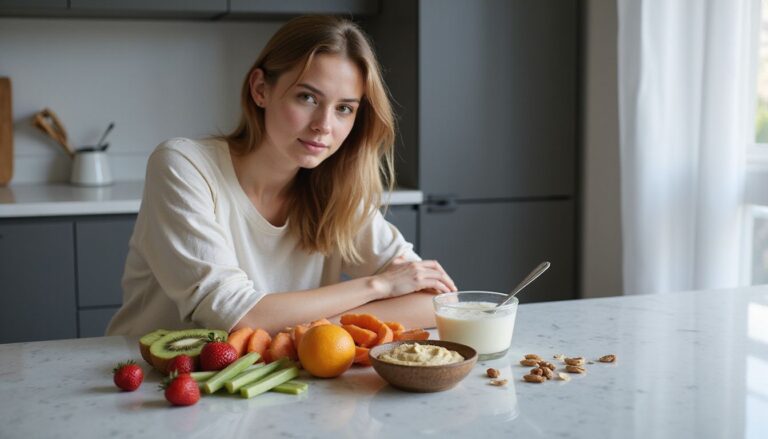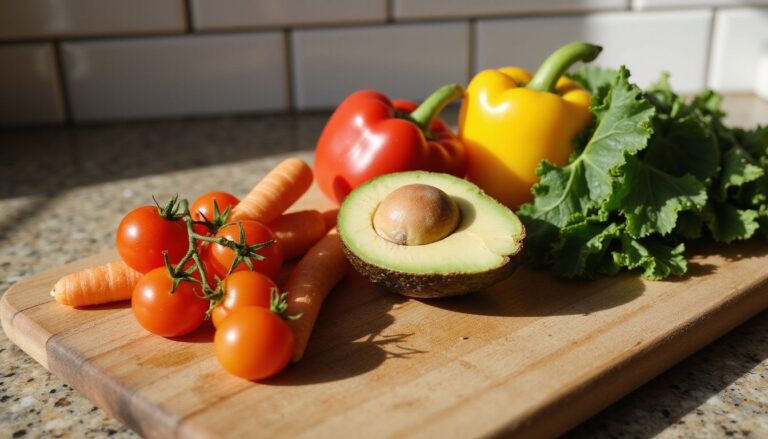Effective 30-Day Meal Plan For Weight Loss Female
Our Nutrition Assistant AI Suite will transform your body. You will lose fat, get toned, and build muscle. Gain confidence and optimal health.
Sticking to healthy eating can feel confusing. A simple 30-day meal plan for weight loss gives clear steps and removes guesswork. With steady portions and a calorie target, many women lose about 1 to 2 pounds per week, which aligns with guidance from the U.S. Department of Health and Human Services.
This guide shows you how to set up your plan, pick nutrient-dense foods, and stay consistent for the next 30 days. You will find easy recipes, smart meal prep tips, and advice to stay motivated.
Key Takeaways
- Women can lose about 1 to 2 pounds per week with a structured 30-day plan that follows calorie and portion goals.
- Balanced macronutrients, meaning protein, carbohydrates, and healthy fats, help control hunger and protect muscle during weight loss.
- Calorie deficit plus portion control is essential. Using meal prep containers makes consistent servings easier at breakfast, lunch, and dinner.
- Hydration aids appetite control and metabolism. Aim for at least eight cups of water each day.
- Planning nutrient-dense meals improves diet quality and satisfaction. Studies link planning with better long-term habits for women.
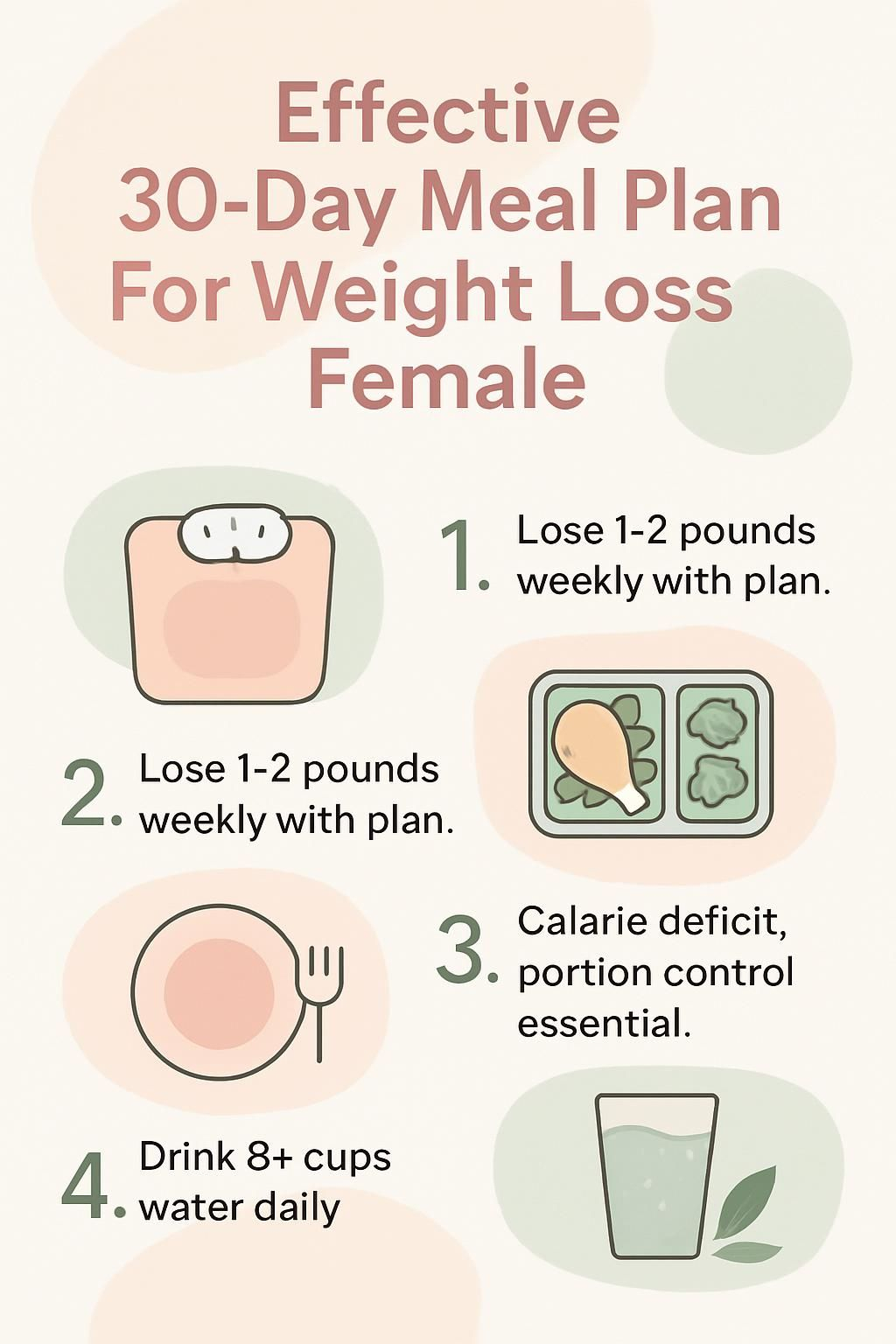
Understanding a 30-Day Meal Plan for Weight Loss
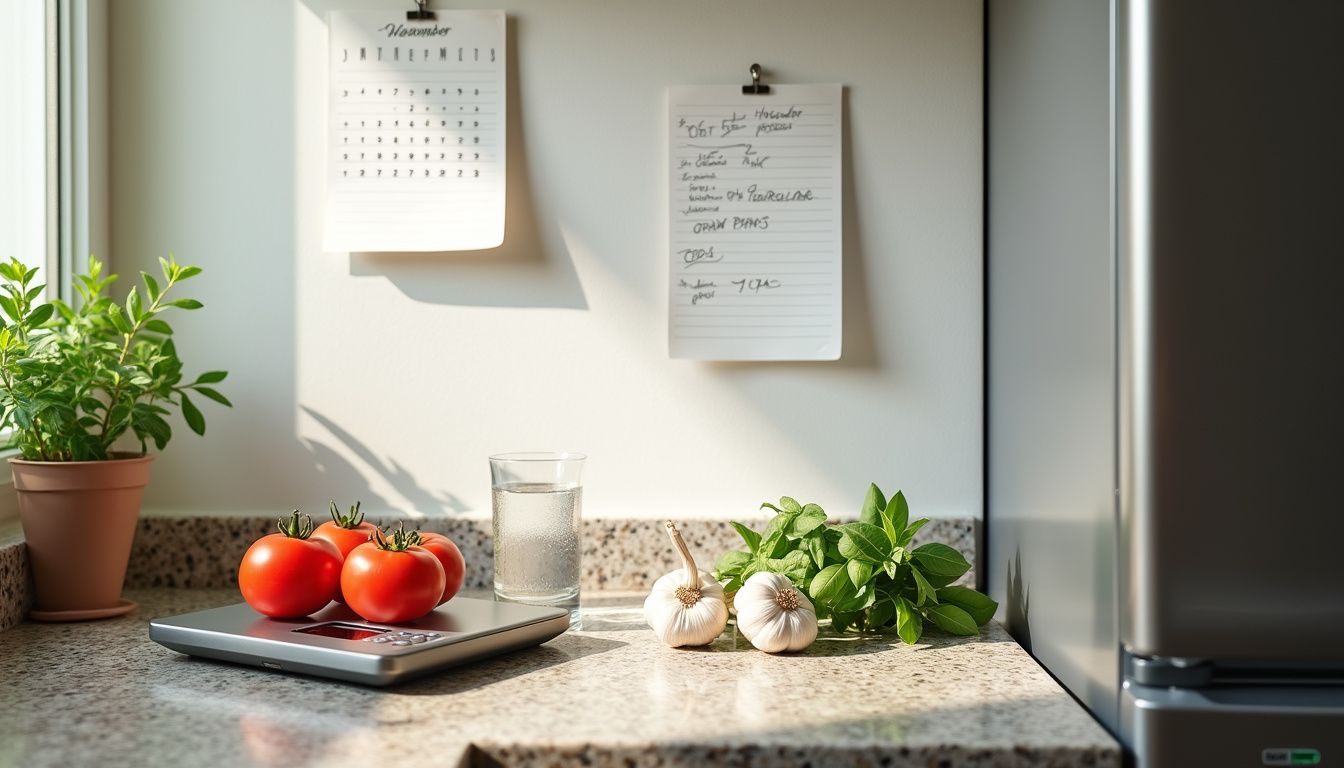
A 30-day meal plan for weight loss gives you structure and daily support. Clear steps make it easier to build healthy habits and hit your goals.
Why Are Structured Meal Plans Important?
Structured plans reduce guesswork and keep you focused. A diet plan for weight loss makes portion control simple and helps you track calories so you can maintain a healthy calorie deficit.
People who plan their meals often lose about 1 to 2 pounds per week, according to federal health guidance. Planning also reduces decision fatigue because you know what you will eat ahead of time.
Registered dietitians point out that simple plans help you get enough protein, healthy fats, and fiber each day without complicated rules.
“Meal planning is linked to improved nutrition quality and weight management.”
Next, see how a full month of planning can add up to real benefits.
What Are the Benefits of a 30-Day Meal Plan?
A 30-day plan builds a routine that makes healthy choices easier. You avoid last-minute snacks and drive-thru meals that raise calories fast.
Planning ahead helps you include lean protein, fruits and vegetables, whole grains, strained yogurt, and healthy fats like avocado and nuts. Over a month, tracking meals also reveals your eating patterns.
Many people cook more at home and cut processed foods, which supports portion control. Balanced meals can steady energy for exercise and reduce cravings by limiting added sugar and excess sodium.
Clear daily guidelines create momentum. Wins stack up, which keeps you motivated for the next week.
Key Components of an Effective Weight Loss Meal Plan
A strong plan blends calorie control, smart portions, and nutritious foods. The goal is to feel full, stay consistent, and protect your health while you lose fat.
How Does Calorie Deficit and Portion Control Help?
Weight loss happens in a calorie deficit, which means eating fewer calories than your body uses. That encourages your body to tap stored energy. This approach aligns with the Dietary Guidelines for Americans and research on long-term weight loss.
Portion control helps you avoid accidental overeating at each meal. On day 1 or day 13, measuring servings can keep you on track at breakfast, lunch, and dinner.
“You do not have to eat less, just eat right.”
Portion containers or a food scale make serving sizes consistent. Choose best foods for weight loss: lean protein like chicken or strained Greek yogurt, high-fiber vegetables such as kale and bell pepper, whole grains like brown rice and oat toast, and healthy fats like olive oil. These choices keep you full longer and help prevent rebound weight gain.
Studies show calorie control remains important whether you aim to lose in 30 days or make steady progress on day 16 or day 23 of your plan.
What Is the Role of Balanced Macronutrients?
Macronutrients are protein, carbohydrates, and fat. Protein helps build and keep lean muscle, especially if you do strength training. Carbohydrates from whole grains, beans, and vegetables give steady energy for daily movement. Healthy fats from nuts and seeds support heart health and help manage hunger hormones like ghrelin and leptin.
Balanced plates reduce cravings, which makes it easier to stay within your calorie target. Many people notice on day 9 or day 17 that mixing protein sources raises satisfaction and keeps hunger away.
How to Incorporate Nutrient-Dense Foods?
Nutrient-dense foods pack vitamins, minerals, and fiber into fewer calories. Fill half your plate with high-fiber vegetables such as broccoli, spinach, cauliflower, and cucumbers. Choose lean protein like grilled chicken, fish, or tofu for most meals.
Swap white bread or rice for whole grains such as quinoa, oats, and brown rice. Add healthy fats from nuts, seeds, avocados, and a small amount of cheddar cheese for flavor and fullness.
Pick fruits that are rich in vitamin C and low in calories, like berries or citrus. Sip water during the day instead of sweetened beverages. For snacks on day 3 or day 15, try strained yogurt with fruit or carrots with hummus instead of chips.
On day 10, prewashing salad greens and storing them in a glass container helped me eat better on busy nights. Use herbs and spices for flavor to limit extra salt and sugar.
Why Is Hydration Important for Weight Loss?
Water supports digestion and nutrient transport. Drinking water before meals may help you feel full sooner, which supports portion control and a calorie deficit.
Hydration also helps your body use fat for energy and can make workouts feel easier. Experts suggest about eight cups daily, though needs vary by body size and activity level.
Week 1: Building the Foundation
Start simple this week. Pick basic recipes, build a routine, and set up habits you can repeat.
What Are Some High-Protein, Low-Calorie Breakfast Ideas?
Breakfast with enough protein boosts fullness and helps your weight loss program. Try these options to support a calorie deficit and steady energy.
- Scrambled egg whites with spinach and tomatoes, about 90 calories and 18 grams of protein, great for day 5 or day 14.
- Greek yogurt with berries and one tablespoon chia seeds, about 120 calories and over 15 grams of protein, plus fiber.
- Cottage cheese with sliced peach, about 110 calories and 13 grams of protein, helpful for weight control.
- Smoked salmon on one whole grain rice cake, about 130 calories and 12 grams of protein, with healthy fats that may support insulin resistance during PCOS or menopause.
- Protein smoothie with 1 cup unsweetened almond milk, 1 scoop protein powder, and half a banana, about 150 calories and 22 grams of protein.
- Omelet with 2 egg whites, mushrooms, and bell peppers, about 90 calories and 16 grams of protein to support a healthy weight.
- Tofu scramble with kale, cherry tomatoes, and nutritional yeast, about 130 calories and 15 grams of protein, plus magnesium.
- Strained yogurt with diced apple and cinnamon, about 100 calories and 10 grams of protein, rich in calcium.
- Lean turkey sausage links with grilled zucchini, about 120 calories and 14 grams of protein.
Next, match your breakfast with lean proteins and whole grains at lunch to keep energy steady through the afternoon.
Which Lean Proteins and Whole Grains Are Best for Lunch?
Lunchtime is a great moment to lock in protein, fiber, and steady energy. Rotate these choices through the week.
- Grilled chicken breast or turkey keeps saturated fat low and supports muscle health.
- Canned tuna or salmon in water adds omega 3s. Add to salads or wraps.
- Lentils, chickpeas, or black beans bring plant protein and fiber for digestive health.
- Cooked quinoa provides all nine essential amino acids and about 8 grams of protein per cup.
- Brown rice is gluten free and rich in magnesium, selenium, and fiber.
- Whole wheat pita or bread offers lasting energy compared to refined grains.
- Pair skinless chicken with farro or barley to support fullness across the day.
- Add a small portion of nuts like almonds or walnuts for healthy fats.
- Try bulgur or wild rice to keep processing low and nutrients higher.
- Rotate protein and grain sources to avoid boredom and cover more nutrients.
- Use portion containers to manage servings. Aim for about 30 grams of fiber daily, as supported by peer-reviewed research.
What Are Low-Carb, High-Vegetable Dinner Options?
Dinners with fewer carbs and more vegetables can support your calorie target and fiber goals.
- Grilled chicken with broccoli, bell peppers, and zucchini. Add olive oil for flavor and healthy fat.
- Shrimp stir fry over cauliflower rice with snap peas and spinach to keep carbs low yet filling.
- Sheet pan salmon with asparagus for protein and omega 3 fats linked to heart health.
- Turkey or tofu with zucchini noodles, cherry tomatoes, and basil for a pasta feel with fewer carbs.
- Vegetable frittata with spinach, tomatoes, mushrooms, and a bit of low fat cheese for quick protein.
- Beef and cabbage skillet with garlic, onions, and shredded carrots using simple pantry items.
- Mixed greens with grilled chicken, nuts, and avocado plus a light vinaigrette for a filling salad.
- Baked cod with roasted Brussels sprouts and red onions for a light, flavorful fish dinner.
- A large batch of vegetable soup with beans keeps dinner easy on busy days like day 29 or day 30.
To support your plan between meals, add smart snacks that prevent overeating at night.
What Healthy Snacks Can I Eat Between Meals?
Healthy snacks help control hunger and keep energy stable. Use small portions and pick foods with protein or fiber.
- Greek yogurt with fresh berries for protein, calcium, and antioxidants.
- Apple or banana with a thin layer of nut butter for fiber and healthy fats.
- Carrot and cucumber sticks with hummus for protein and crunch.
- Air popped popcorn with light seasoning, three cups at about 100 calories, ideal for day 7 or day 18.
- Cottage cheese with pineapple or peach for protein and calcium on day 20 or day 26.
- Hard boiled eggs, one or two for less than 150 calories.
- Roasted chickpeas or edamame for a crunchy plant protein swap for chips.
- A small handful of almonds or walnuts to help you reach your 30 gram fiber goal across the day.
- Cherry tomatoes with a low fat mozzarella stick for protein and vitamin C.
- Sliced bell peppers with salsa or a low calorie dip for volume and nutrients.
- Homemade protein bars with oats, seeds, and honey to control added sugar, useful on day 22 or day 25.
On a hiking trip in Vermont, roasted chickpeas kept my energy up and curbed afternoon cravings. Smart snacks like these make consistency easier.
Week 2: Increasing Variety
Fresh flavors help you stay engaged. Variety reduces boredom and supports a nutrient-dense diet.
What Are Nutritious Smoothie and Overnight Oat Recipes?
These quick recipes add protein, fiber, and vitamins to your plan. They also support a calorie deficit without much effort.
- Smoothie: 1 cup spinach, half a banana, 1 scoop plant protein, 1 cup unsweetened almond milk.
- Overnight oats: half cup rolled oats, three quarter cup low fat Greek yogurt, half cup blueberries.
- Smoothie: 1 cup frozen mixed berries, 1 tablespoon chia seeds, 1 cup water, 1 teaspoon honey.
- Overnight oats: half cup oats, 1 tablespoon peanut butter, 1 cup unsweetened soy milk.
- Green smoothie: 1 cup kale, half an apple, 1 tablespoon flaxseed, 1 cup coconut water.
- Overnight oats: half cup oats, half cup almond milk, half chopped apple, cinnamon.
- Smoothie: 1 cup strawberries, 1 scoop protein powder, 1 tablespoon almond butter, 1 cup low fat milk.
- Overnight oats: half cup oats, 1 tablespoon pumpkin seeds, half mashed banana, 1 cup low fat milk.
How to Make Salads with Grilled Proteins for Lunch?
Salads with grilled proteins are filling and easy to prep. Keep portions consistent.
- Choose lean protein such as grilled chicken, turkey, tofu, shrimp, or salmon, about 3 to 4 ounces.
- Season with herbs and spices. Use minimal oil for grilling.
- Use greens such as spinach, kale, or mixed lettuce for fiber and volume.
- Add colorful vegetables like bell peppers, tomatoes, cucumbers, and carrots.
- Include a small amount of healthy fat, such as 1 tablespoon olive oil or a sprinkle of seeds.
- Add a small serving of whole grains, about one third cup quinoa or brown rice.
- Make a light dressing with vinegar, lemon, and spices to limit added sugar.
- Assemble right before eating, or store greens and protein separately.
- Portion meals in containers to prevent overeating and save time.
- Adjust quantities as your calorie needs change, based on progress and activity.
What Are Easy One-Pan Dinners with Healthy Fats?
One-pan dinners cut cleanup and make it simple to add healthy fats to dinner.
- Roasted salmon with olive oil, lemon, and broccoli on a sheet pan. Omega 3 fats support heart health.
- Chicken breast sautéed with cherry tomatoes and spinach in avocado oil. Monounsaturated fats can help manage hunger.
- Turkey sausage with diced sweet potatoes and bell peppers in a small amount of coconut oil. Medium chain fats may support energy use.
- Shrimp with zucchini and red onions in extra virgin olive oil for lean protein and flavor.
- Tofu, mushrooms, and Brussels sprouts tossed with sesame oil and low sodium soy sauce for plant protein and variety.
- Lean steak strips with asparagus and cherry tomatoes in a light brush of canola oil for a balanced plate.
- Mediterranean frittata with eggs, kale, tomatoes, and feta in a quick olive oil spray.
Using more one-pan meals cut my kitchen time in half last month. Mixing lean proteins with healthy oils kept me full longer.
What Are Good Vegetable Snacks with Dips?
Vegetable snacks add volume without many calories. Pair them with a protein rich dip for staying power.
- Carrots, celery, and bell peppers with hummus for protein and crunch.
- Grilled zucchini or asparagus with a Greek yogurt dip for extra protein.
- Romaine leaves with a cottage cheese dip for calcium.
- Cherry tomatoes with guacamole for healthy fats and flavor.
- Steamed broccoli florets with salsa for a spicy, high fiber bite.
- Cucumber rounds with light ranch or tzatziki; high water content supports hydration.
- Radish slices with bean dip for added fiber and fullness.
Week 3: Optimizing Nutrition
This week you fine tune nutrients and portions. Small improvements can unlock steady progress.
What Are Healthy Egg-Based Breakfast Recipes?
Eggs are rich in protein and support fullness. Research shows higher protein breakfasts can lower daily calorie intake.
- Scrambled eggs with spinach and tomatoes, plus a slice of whole grain toast.
- Veggie omelet with bell peppers, onions, and mushrooms cooked in olive oil.
- Two boiled eggs with half a small avocado, lemon, and pepper.
- Egg muffins with chopped broccoli and a bit of low fat cheese baked for 20 minutes at 350°F.
- Poached eggs on whole grain toast with sliced tomatoes.
- Greek style bowl with sautéed kale, a sunny side egg, a little feta, and cucumbers.
- Egg and cottage cheese wrap on a whole wheat tortilla with diced tomatoes.
- Shakshuka, eggs simmered in tomato sauce with onions and peppers.
- Egg white sandwich on whole grain bread with fresh spinach and a slice of turkey bacon.
During a 30-day challenge, these breakfasts helped me avoid midmorning snacking and kept me on track.
How to Prepare Quinoa and Vegetable Bowls for Lunch?
Quinoa bowls make balanced lunches that are easy to prep in batches.
- Start with half a cup cooked quinoa for complete protein and fiber.
- Add at least one cup of roasted or grilled vegetables, such as peppers, zucchini, broccoli, or carrots.
- Include 3 to 4 ounces of lean protein, like chicken, tofu, or chickpeas.
- Top with one tablespoon olive oil or a quarter avocado for healthy fat.
- Use fresh herbs and lemon juice for flavor without extra calories.
- Prep several bowls and store in airtight containers for quick lunches.
- Drink water with your meal to support appetite control.
What Are Healthy Fish, Brown Rice, and Steamed Veggie Dinners?
Fish dinners with whole grains and vegetables are simple, balanced, and satisfying.
- Choose lean fish like cod, tilapia, or salmon for quality protein and omega 3 fats.
- Measure brown rice to one half cup cooked per meal for fiber and steady energy.
- Steam non starchy vegetables such as broccoli, carrots, or asparagus for volume and vitamins.
- Season with herbs, lemon juice, or spices instead of creamy sauces to control calories and sodium.
- Grill, bake, or broil fish rather than fry to reduce added fat.
- Drink a glass of water or herbal tea with dinner to support fullness.
- Make extra rice and vegetables to save time on busy nights. Cooked fish keeps for up to two days in the refrigerator.
- Planning these dinners helped me skip takeout and stay within my calorie budget.
Experts note that balanced meals with fish, whole grains, and vegetables can aid weight loss for females who follow them consistently.
How to Make Homemade Protein Bars for Snacks?
Homemade bars let you control protein, calories, and sugar. They are great for grab and go fuel.
- Gather rolled oats, nut butter, protein powder, honey, and mix ins like flaxseed or chopped nuts.
- Measure protein and oats to reach 8 to 15 grams of protein per bar.
- Combine dry ingredients in a bowl and stir well.
- Add nut butter and honey. Mix until a thick dough forms.
- Press into a lined pan and smooth the top.
- Chill for at least one hour so the bars set.
- Slice into equal pieces for portion control. Store up to seven days in an airtight container.
- Log nutrition per bar in an app to track intake.
Next, try quick Greek yogurt and berry breakfasts that fit well in your 30-day meal plan for weight loss.
Week 4: Maintaining Momentum
This week, you focus on repeatable habits that keep progress going. Simple meals and smart snacks make consistency easier.
What Are Quick Greek Yogurt and Fresh Berry Breakfasts?
Greek yogurt with fresh berries delivers protein fast on busy mornings. It also supports appetite control.
- Use one cup low fat plain Greek yogurt, about 20 grams of protein and roughly 100 calories.
- Add half a cup of berries for antioxidants and about 35 to 40 calories.
- Sprinkle one tablespoon chia seeds for fiber and omega 3 fats.
- Stir in a teaspoon of honey or a few drops of vanilla for light sweetness.
- Prep several bowls in advance for grab and go meals.
- Layer yogurt and berries in a clear container to make a quick parfait.
- Pair with water or green tea to start hydration early.
What Are Simple Soup and Salad Lunch Combos?
Soup and salad combos feel light yet filling. They are easy to prep ahead for several days.
- Low sodium vegetable soup plus a mixed green salad with grilled chicken. Protein at lunch can reduce afternoon hunger.
- Lentil or bean soup with a spinach salad, cherry tomatoes, and a small sprinkle of feta. Legumes support fullness and gut health.
- Tomato soup with an arugula salad and shredded carrots. Add a teaspoon of olive oil to boost nutrient absorption.
- Chicken and rice soup with a kale salad topped with pumpkin seeds for minerals and crunch.
- Minestrone soup with a romaine salad, red bell peppers, and cucumbers to raise nutrient variety.
- Miso soup with a cabbage and edamame salad for probiotics and plant protein.
- Pureed carrot ginger soup with a spring mix salad and a hard boiled egg for extra protein.
Batch cooking soup and prepping salads on weekends saved me time and reduced lunchtime stress. Portion control felt much easier during the workweek.
How to Cook Grilled Chicken and Roasted Vegetables for Dinner?
Grilled chicken with roasted vegetables offers lean protein and fiber without many calories.
- Use 4 to 6 ounces of skinless chicken per serving. Trim excess fat and pat dry.
- Mix olive oil, lemon juice, garlic powder, salt, and pepper. Coat chicken and marinate 10 to 15 minutes.
- Preheat the grill to medium high. Cook chicken 5 to 7 minutes per side until 165°F inside.
- Cut bell peppers, zucchini, carrots, and broccoli into even pieces.
- Toss vegetables with olive oil, salt, pepper, and dried herbs like thyme or oregano.
- Roast at 425°F for 20 to 25 minutes, stirring once.
- Plate the chicken with a generous portion of vegetables. Add fresh herbs to finish.
- Drink water with dinner to support fullness and hydration.
- Cooking this meal on repeat helped me avoid late night snacking and kept cravings low.
What Are Healthy Snack Options like Popcorn or Cottage Cheese?
Cottage cheese and popcorn are budget friendly and satisfying. Rotate them with other high protein or high fiber snacks.
- Air popped popcorn at about 30 calories per cup with light seasoning.
- Low fat cottage cheese, about 12 grams of protein and under 100 calories per half cup.
- Cucumbers or bell peppers with hummus for hydration, vitamins, and fiber.
- Plain nonfat Greek yogurt with fresh berries for protein and antioxidants.
- Hard boiled eggs with 6 grams of protein each for an easy option.
- Apple slices with a tablespoon of nut butter for fiber and healthy fats.
- Rice cakes with avocado for whole grain crunch and healthy fats, about 35 calories per cake.
- Baby carrots or cherry tomatoes with a low calorie dip for crunch.
- Edamame, half a cup at about 90 calories with 8 grams of protein.
- Part skim string cheese for protein and calcium. Pick reduced fat options.
These choices help reduce cravings and keep you satisfied between meals.
Best Foods for Weight Loss
Choosing the right foods helps you follow your 30-day meal plan and hit your calorie goals without constant hunger.
What Are the Best Lean Protein Choices?
Skinless chicken breast offers about 26 grams of protein and roughly 1 gram of fat per 3 ounce cooked serving. Turkey breast is similar and keeps fat low.
White fish like cod, tilapia, or haddock typically contain under 2 grams of fat and at least 15 grams of protein per serving. Salmon has more fat, yet it provides heart friendly omega 3s.
Plant proteins like tofu and tempeh supply complete protein for vegetarian diets and usually have less than 10 grams of fat per 3 ounce serving. Low fat cottage cheese, Greek yogurt, and eggs are convenient options for breakfast and snacks.
Using a mix of sources helps you meet protein needs and feel full while keeping calories controlled.
Which High-Fiber Vegetables Aid Weight Loss?
Broccoli, cauliflower, and Brussels sprouts are fiber rich and filling. One cup of broccoli offers about 2.4 grams of fiber, and the same amount of Brussels sprouts provides over 3 grams.
Leafy greens like spinach and kale are low in calories and easy to add for volume. Carrots deliver crunch with nearly 3 grams of fiber per cup. Bell peppers add flavor and close to 2 grams of fiber per serving.
Filling half your plate with these vegetables can reduce late night cravings. Harvard Health Publishing has highlighted the link between fiber rich foods and weight control.
Whole grains also help. See which ones to include next.
What Whole Grains Should I Include?
Whole grains work with vegetables to boost fullness and steady energy. Brown rice, quinoa, oats, barley, bulgur, and whole wheat bread bring fiber, B vitamins, and minerals like magnesium and iron.
Add cooked quinoa to salads or use brown rice in stir fries. Try overnight oats with berries for breakfast or make sandwiches with 100 percent whole wheat bread.
A 2018 study found that adults who ate at least three servings of whole grains daily had lower body mass indexes than those who ate refined grains. Small swaps across the week add up.
Which Healthy Fats Support Weight Loss?
Avocados, almonds, walnuts, and chia seeds provide healthy fats that support fullness when eaten in modest portions. Olive oil works well for salads and cooking with less saturated fat.
Research in the American Journal of Clinical Nutrition reported that replacing refined carbohydrates with healthy fats can improve weight loss results through better satiety.
Adding a tablespoon of flaxseed to yogurt or choosing a handful of nuts in the afternoon may hold you longer between meals. Fatty fish like salmon or mackerel also support appetite control through omega 3s.
What Low-Calorie Fruits Are Recommended?
Berries such as strawberries, blueberries, and raspberries are low in calories and high in fiber. One cup of strawberries has about 50 calories and plenty of vitamin C.
Watermelon has around 46 calories per cup and adds hydration. Oranges are about 60 calories each and rich in vitamin C. Apples and peaches are near 60 calories per serving. Half a grapefruit is about 52 calories and can help with appetite control. Fresh pineapple offers fewer than 85 calories per cup for a bright, sweet option.
These fruits fit your calorie goals while keeping meals enjoyable.
Tips for Meal Preparation and Planning
Planning ahead saves time and helps you meet your calorie target. It also reduces stress on busy days.
How Can I Prepare Meals in Advance?
Prepping before the week begins supports your plan and prevents impulse eating.
- Create a weekly menu based on your 30-day meal plan. List breakfast, lunch, dinner, and snacks so shopping is focused.
- Cook proteins like chicken, turkey, or fish in bulk. Portion them into containers for quick meals.
- Wash, chop, and portion vegetables after shopping. Store in airtight containers.
- Use portion containers for cooked meals to control intake.
- Cook large batches of brown rice or quinoa to reheat through the week.
- Pre portion snacks such as nuts or fresh fruit to avoid overeating.
- Log meals in a food journal or app to learn what works best.
- Freeze extra servings so you have healthy backup meals.
Doing a one hour prep on Sundays helped me stay consistent all week. Having ready meals lowered my stress and supported steady weight loss.
How to Use Portion Containers Effectively?
Portion containers make serving sizes simple. They also help you follow your plan without constant measuring.
- Label each container for protein, vegetables, fruits, or carbohydrates. Color coding helps.
- Fill them with whole foods before meals to save time during the day.
- Use measuring cups or a food scale while filling to keep calories on target.
- Match portions to your daily calorie goal and adjust on workout days if needed.
- Rotate different foods within each container type to keep meals interesting.
- Pack portioned snacks like cut veggies or nuts instead of eating from large bags.
- Track how satisfied you feel after meals and adjust portions if needed.
- Clean and stack containers right after use to make prep easy tomorrow.
- Share tips with a friend for extra accountability.
Portioning was a game changer during my own 30-day weight loss period. It helped me avoid mindless snacking and see progress week by week.
How to Rotate Recipes to Avoid Boredom?
Rotating recipes keeps meals fresh and supports long term success.
- Plan a weekly menu with new recipes every seven days to reduce repetition.
- Explore different cuisines, such as Mexican, Mediterranean, or Asian inspired dishes.
- Switch cooking methods like grilling, roasting, steaming, or slow cooking to change texture and taste.
- Use seasonal produce. Summer might bring berries and tomatoes; winter can feature squash and leafy greens.
- Change protein sources across the week, such as chicken, fish, tofu, eggs, and beans.
- Swap sauces and spices. Lean on lemon, herbs, garlic, and light dressings for flavor.
- Follow recipe blogs or social pages for quick ideas you can use right away.
- Rebuild favorite meals in lighter ways, like lettuce wrap tacos or spiralized vegetable pasta.
- Sharing a healthy potluck with friends adds fun and fresh ideas during your 30-day plan.
Tracking Progress and Adjustments
Clear feedback keeps motivation high. Watch trends, not single days, and adjust with small steps.
How Do I Monitor Weight and Measurements?
Weigh yourself once a week at the same time, such as morning before breakfast. Use a digital scale and record your weight in a notebook or app.
Measure your waist, hips, arms, and thighs every two weeks with a soft tape. Stand relaxed and write down each number to track changes.
Take photos from the front, side, and back in similar clothing each month. Store notes and photos together to see your full progress over time.
Using both the scale and measurements gives a clearer picture than either one alone.
When Should I Adjust My Calorie Intake?
If progress stalls for more than two weeks, consider trimming daily calories slightly. A change in daily activity or workouts may also call for an adjustment.
Feeling very tired, losing strength, or having constant hunger can mean you need more calories. Review your food log and step count before you change your target.
My weight loss slowed in week three of a past plan. After checking my steps and snacks, I cut about 150 calories and progress resumed.
Small shifts can keep momentum going without making the plan hard to follow.
Common FAQs About 30-Day Meal Plans
Here are straightforward answers to questions women ask before starting a 30-day meal plan for weight loss.
How Much Weight Can I Lose in 30 Days?
Many women lose 4 to 8 pounds in 30 days with a steady calorie deficit and consistent planning. That rate of 1 to 2 pounds per week is considered safe and more likely to last.
Results depend on starting weight, calorie intake, activity level, age, and consistency. Some people see faster loss in the first week from water changes, especially if they cut sodium or refined carbs.
Most lasting progress comes from fat loss later in the month. Track your meals and activity to stay motivated.
Is This Meal Plan Sustainable for the Long Term?
Yes, you can keep using a 30-day plan with small adjustments to match your life. Balanced plans with lean proteins, whole grains, healthy fats, and plenty of vegetables support long term weight management and heart health.
Harvard researchers report that people who follow structured healthy eating patterns are less likely to regain weight. Batch cooking and rotating recipes made it easier for me to stay consistent without feeling bored.
If progress slows or your schedule changes, adjust calories or portions while keeping the basic structure. Continuity matters more than perfection.
Conclusion
A 30-day meal plan offers structure, balance, and daily wins as you work toward weight loss for women. Planned meals support a calorie deficit while covering your nutrition needs.
Each week builds on the last to keep meals effective and interesting. Choose nutrient-dense foods, use portion control, and stay hydrated. Track your progress and make small adjustments as needed.
With steady effort, you will see positive changes in weight and health. If you have a medical condition, are pregnant, or take medications, consult a registered dietitian or your healthcare professional before major diet changes. An evidence based meal plan, supported by sources like the Dietary Guidelines for Americans, can set a strong foundation for long term healthy habits.
FAQs
1. What is an effective 30-day meal plan for weight loss in women?
An effective 30-day meal plan for weight loss in women includes balanced portions of lean protein, whole grains, fruits, and vegetables. Research from the Academy of Nutrition and Dietetics suggests that a daily calorie deficit of 500 to 750 calories can help most women lose about one to two pounds per week. A sample daily intake might include 1,200 to 1,500 calories, depending on age and activity level. Tracking intake with a food diary or app can improve results.
2. How does a 30-day meal plan support weight loss for females?
A structured meal plan helps control calorie intake and encourages healthy food choices. Studies show that planning meals in advance reduces impulsive eating and increases the likelihood of meeting nutrition goals. For example, a randomized trial in the Journal of Obesity found that women who followed a meal plan lost more weight than those who did not plan meals.
3. What foods should be included or avoided in a 30-day weight loss meal plan for women?
Include foods high in fiber, such as oats, beans, berries, and leafy greens; these help with fullness and digestion. Lean proteins like chicken breast, fish fillets, tofu, and eggs support muscle maintenance during weight loss. Limit processed snacks, sugary drinks, fried items, and refined grains; these add empty calories and slow progress.
4. Can personal experience improve success with a 30-day meal plan for female weight loss?
Personal experience can guide food choices and help identify what works best for each person. For instance, one woman found that preparing lunches ahead of time reduced her temptation to buy fast food during workdays. Keeping a journal of meals and feelings can reveal patterns that support long-term success.
Summary: A well-designed 30-day meal plan for female weight loss uses evidence-based guidelines to balance nutrients and control portions. Including whole foods while limiting processed items supports steady progress. Personal experience with planning and tracking can further improve results over time.

